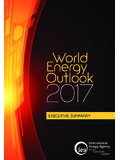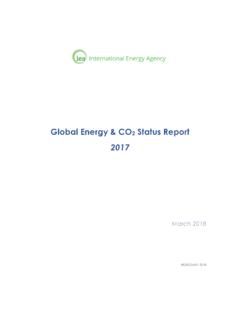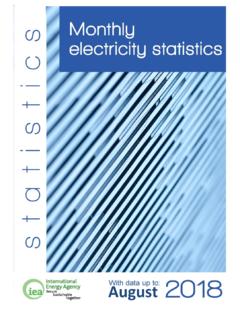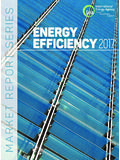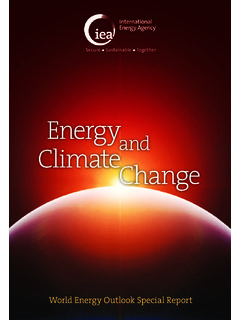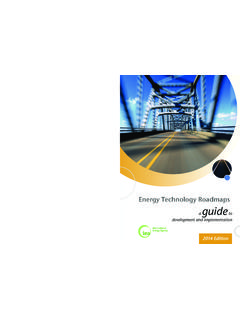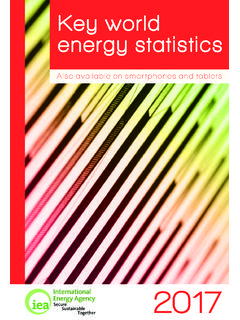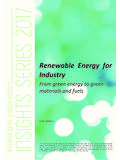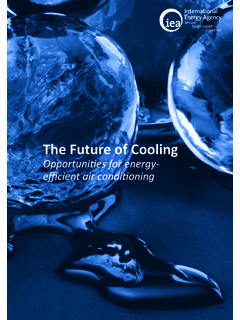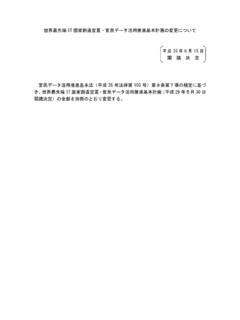Transcription of World Energy Outlook 2017 - International Energy …
1 2017 WorldEnergyOutlookEXECUTIVE SUMMARYINTERNATIONAL Energy AGENCYThe International Energy Agency (IEA), an autonomous agency, was established in November 1974. Its primary mandate was and is two-fold: to promote Energy security amongst its member countries through collective response to physical disruptions in oil supply, and provide authoritative research and analysis on ways to ensure reliable, affordable and clean Energy for its 29 member countries and beyond. The IEA carries out a comprehensive programme of Energy co-operation among its member countries, each of which is obliged to hold oil stocks equivalent to 90 days of its net imports. The Agency s aims include the following objectives: nSecure member countries access to reliable and ample supplies of all forms of Energy ; in particular, through maintaining effective emergency response capabilities in case of oil supply Promote sustainable Energy policies that spur economic growth and environmental protection in a global context particularly in terms of reducing greenhouse-gas emissions that contribute to climate change.
2 NImprove transparency of International markets through collection and analysis ofenergy data. nSupport global collaboration on Energy technology to secure future Energy suppliesand mitigate their environmental impact, including through improved energyefficiency and development and deployment of low-carbon solutions to global Energy challenges through engagement and dialogue with non-member countries, industry, International organisations and other member countries: Australia Austria Belgium CanadaCzech RepublicDenmarkEstoniaFinlandFranceGerma nyGreeceHungaryIreland ItalyJapanKoreaLuxembourgNetherlandsNew Zealand NorwayPolandPortugalSlovak RepublicSpainSwedenSwitzerlandTurkeyUnit ed KingdomUnited StatesThe European Commission also participates in the work of the IEA. OECD/IEA, 2017 International Energy Agency Website: note that this publication is subject to specific restrictions that limit its use and distribution.
3 The terms and conditions are available online at Summary1 Executive SummaryFour large-scale shifts in the global Energy system set the scene for the World Energy Outlook - 2017 (WEO- 2017 ): The rapid deployment and falling costs of clean Energy technologies; in 2016, growthin solar PV capacity was larger than for any other form of generation; since 2010, costsof new solar PV have come down by 70%, wind by 25% and battery costs by 40%. The growing electrification of Energy ; in 2016, spending by the World s consumers onelectricity approached parity with their spending on oil products. The shift to a more services-oriented economy and a cleaner Energy mix in China, theworld s largest Energy consumer, subject of a detailed focus in this Outlook . The resilience of shale gas and tight oil in the United States, cementing its position asthe biggest oil and gas producer in the World even at lower shifts come at a time when traditional distinctions between Energy producers and consumers are being blurred and a new group of major developing countries, led by India, moves towards centre stage.
4 How these developments play out and interact is the story of this Outlook , with particular attention paid to their implications for natural gas, this year s fuel focus. Together, they are opening up new perspectives for affordable, sustainable access to modern Energy , reshaping responses to the World s pressing environmental challenges, and entailing a reappraisal and reinforcement of approaches to Energy security. Our new Outlook describes multiple future pathways for global Energy through to 2040. Among them, the New Policies Scenario describes where existing policies and announced intentions might lead the Energy system, in the anticipation that this will inform decision-makers as they seek to improve on this outcome. The Sustainable Development Scenario, a major new scenario introduced in the WEO- 2017 , outlines an integrated approach to achieve the Energy -related aspects of the UN Sustainable Development Goals: determined action on climate change; universal access to modern Energy by 2030; and a dramatic reduction in air pollution.
5 These are all areas in which progress in the New Policies Scenario falls short of what would be an extra China-plus-India to global Energy demand by 2040In the New Policies Scenario, global Energy needs rise more slowly than in the past but still expand by 30% between today and 2040, the equivalent of adding another China and India to today s global demand. A global economy growing at an average rate of per year, a population that expands from billion today to more than 9 billion in 2040, and a process of urbanisation that adds a city the size of Shanghai to the World s urban population every four months are key forces that underpin our projections. The largest contribution to demand growth almost 30% comes from India, whose share of global Energy use rises to 11% by 2040 (still well below its 18% share in the anticipated global population). Southeast Asia, a region covered in a separate special report in the WEO- 2017 OECD/IEA, 20172 World Energy Outlook 2017series, is another rising heavyweight in global Energy , with demand growing at twice the pace of China.
6 Overall, developing countries in Asia account for two-thirds of global Energy growth, with the rest coming mainly from the Middle East, Africa and Latin America. Renewables step up to the plate; coal strikes outCompared with the past twenty-five years, the way that the World meets its growing Energy needs changes dramatically in the New Policies Scenario, with the lead now taken by natural gas, by the rapid rise of renewables and by Energy efficiency. Improvements in efficiency play a huge role in taking the strain off the supply side: without them, the projected rise in final Energy use would more than double. Renewable sources of Energy meet 40% of the increase in primary demand and their explosive growth in the power sector marks the end of the boom years for coal. Since 2000, coal-fired power generation capacity has grown by nearly 900 gigawatts (GW), but net additions from today to 2040 are only 400 GW and many of these are plants already under construction.
7 In India, the share of coal in the power mix drops from three-quarters in 2016 to less than half in 2040. In the absence of large-scale carbon capture and storage, global coal consumption flatlines. Oil demand continues to grow to 2040, albeit at a steadily decreasing pace. Natural gas use rises by 45% to 2040; with more limited room to expand in the power sector, industrial demand becomes the largest area for growth. The Outlook for nuclear power has dimmed since last year s Outlook , but China continues to lead a gradual rise in output, overtaking the United States by 2030 to become the largest producer of nuclear-based capture two-thirds of global investment in power plants as they become, for many countries, the least-cost source of new generation. Rapid deployment of solar photovoltaics (PV), led by China and India, helps solar become the largest source of low-carbon capacity by 2040, by which time the share of all renewables in total power generation reaches 40%.
8 In the European Union, renewables account for 80% of new capacity and wind power becomes the leading source of electricity soon after 2030, due to strong growth both onshore and offshore. Policies continue to support renewable electricity worldwide, increasingly through competitive auctions rather than feed-in tariffs, and the transformation of the power sector is amplified by millions of households, communities and businesses investing directly in distributed solar PV. Growth in renewables is not confined to the power sector; the direct use of renewables to provide heat and mobility worldwide also doubles, albeit from a low base. In Brazil, the share of direct and indirect renewable use in final Energy consumption rises from 39% today to 45% in 2040, compared with a global progression from 9% to 16% over the same future is electrifyingElectricity is the rising force among worldwide end-uses of Energy , making up 40% of the rise in final consumption to 2040 the same share of growth that oil took for the last twenty-five years.
9 Industrial electric motor systems account for one-third of the increase in power demand in the New Policies Scenario. Rising incomes mean that many millions of households add electrical appliances (with an increasing share of smart connected OECD/IEA, 2017 Executive Summary3285111617391461217410151318devic es) and install cooling systems. By 2040, electricity demand for cooling in China exceeds the total electricity demand of Japan today. The World also gains, on average, 45 million new electricity consumers each year due to expanding access to electricity, although this is still not enough to reach the goal of universal access by 2030. Electricity makes inroads in supplying heat and mobility, alongside growth in its traditional domains, allowing its share of final consumption to rise to nearly a quarter. A strengthening tide of industry initiatives and policy support including recent decisions by governments in France and the United Kingdom to phase out sales of conventional gasoline and diesel vehicles by 2040 pushes our projection for the global electric car fleet up to 280 million by 2040, from 2 million today.
10 To meet rising demand, China needs to add the equivalent of today s United States power system to its electricity infrastructure by 2040, and India needs to add a power system the size of today s European Union. The scale of future electricity needs and the challenge of decarbonising power supply help to explain why global investment in electricity overtook that of oil and gas for the first time in 2016 and why electricity security is moving firmly up the policy agenda. Cost reductions for renewables are not sufficient on their own to secure efficient decarbonisation or reliable supply. The policy challenge is to ensure sufficient investment in electricity networks and in a mix of generation technologies that are the best fit for power system needs, providing the flexibility that is increasingly vital as the contribution of wind and solar PV increases (a consideration that reinforces the links between electricity and gas security). The increasing use of digital technologies across the economy improves efficiency and facilitates the flexible operation of power systems, but also creates potential new vulnerabilities that need to be addressed.
